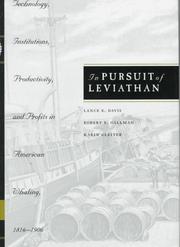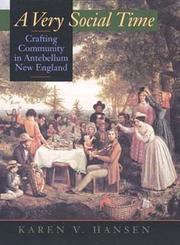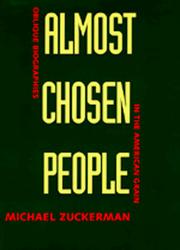| Listing 1 - 10 of 22 | << page >> |
Sort by
|
Book
ISBN: 022653247X Year: 2018 Publisher: Chicago : University of Chicago Press,
Abstract | Keywords | Export | Availability | Bookmark
 Loading...
Loading...Choose an application
- Reference Manager
- EndNote
- RefWorks (Direct export to RefWorks)
From the 1830s to the Civil War, Americans could be found putting each other into trances for fun and profit in parlors, on stage, and in medical consulting rooms. They were performing mesmerism. Surprisingly central to literature and culture of the period, mesmerism embraced a variety of phenomena, including mind control, spirit travel, and clairvoyance. Although it had been debunked by Benjamin Franklin in late eighteenth-century France, the practice nonetheless enjoyed a decades-long resurgence in the United States. Emily Ogden here offers the first comprehensive account of those boom years. Credulity tells the fascinating story of mesmerism's spread from the plantations of the French Antilles to the textile factory cities of 1830s New England. As it proliferated along the Eastern seaboard, this occult movement attracted attention from Ralph Waldo Emerson's circle and ignited the nineteenth-century equivalent of flame wars in the major newspapers. But mesmerism was not simply the last gasp of magic in modern times. Far from being magicians themselves, mesmerists claimed to provide the first rational means of manipulating the credulous human tendencies that had underwritten past superstitions. Now, rather than propping up the powers of oracles and false gods, these tendencies served modern ends such as labor supervision, education, and mediated communication. Neither an atavistic throwback nor a radical alternative, mesmerism was part and parcel of the modern. Credulity offers us a new way of understanding the place of enchantment in secularizing America.
Mesmerism --- Credulity --- History --- History --- agency. --- animal magnetism. --- antebellum United States. --- belief. --- enchantment. --- mesmerism. --- modernity. --- occult. --- secularization. --- spiritualism.
Book
ISBN: 3839437458 9783839437452 Year: 2016 Publisher: Bielefeld
Abstract | Keywords | Export | Availability | Bookmark
 Loading...
Loading...Choose an application
- Reference Manager
- EndNote
- RefWorks (Direct export to RefWorks)
Michael Drescher analyzes national mythologies in American and German literature. He focuses on processes of mythological resignification, a literary phenomenon carrying significant implications for questions of identity, democracy, and nationalism in Europe and America. Precise narratological analyses are paired with detailed, transnational readings of Hawthorne's The Scarlet Letter, Gutzkow's Wally, die Zweiflerin, Brown's Clotel, and Heine's Deutschland. Ein Wintermärchen. The study marries literature, mythology, and politics and contributes to the study of American and German literature at large.
Mythology in literature. --- Myth in literature. --- Mythology; Antebellum America; Vormärz Germany; Politics; National Identity; Narratology; Nathaniel Hawthorne; Karl Gutzkow; William Wells Brown; Heinrich Heine; America; Culture; American Studies; Cultural Studies; American History; Literary Studies --- America. --- American History. --- American Studies. --- Antebellum America. --- Cultural Studies. --- Culture. --- Heinrich Heine. --- Karl Gutzkow. --- Literary Studies. --- Narratology. --- Nathaniel Hawthorne. --- National Identity. --- Politics. --- Vormärz Germany. --- William Wells Brown.
Book
ISBN: 0823267466 0823266346 0823263029 0823263037 0823263002 1322400792 Year: 2014 Publisher: New York : Fordham University Press,
Abstract | Keywords | Export | Availability | Bookmark
 Loading...
Loading...Choose an application
- Reference Manager
- EndNote
- RefWorks (Direct export to RefWorks)
What does it mean to own something? How does a thing become mine? Liberal philosophy since John Locke has championed the salutary effects of private property but has avoided the more difficult questions of property’s ontology. Chad Luck argues that antebellum American literature is obsessed with precisely these questions. Reading slave narratives, gothic romances, city-mystery novels, and a range of other property narratives, Luck unearths a wide-ranging literary effort to understand the nature of ownership, the phenomenology of possession. In these antebellum texts, ownership is not an abstract legal form but a lived relation, a dynamic of embodiment emerging within specific cultural spaces—a disputed frontier, a city agitated by class conflict. Luck challenges accounts that map property practice along a trajectory of abstraction and “virtualization.” The book also reorients recent Americanist work in emotion and affect by detailing a broader phenomenology of ownership, one extending beyond emotion to such sensory experiences as touch, taste, and vision. This productive blend of phenomenology and history uncovers deep-seated anxieties—and enthusiasms—about property across antebellum culture.
American fiction --- Material culture in literature. --- Property in literature. --- Personal belongings in literature. --- History and criticism. --- Affect. --- American Literature. --- Antebellum Culture. --- Eighteenth-Century. --- Embodiment. --- Nineteenth-Century. --- Ownership. --- Phenomenology. --- Property. --- Space.

ISBN: 0226137899 9786611223281 128122328X 0226137902 9780226137902 9780226137896 Year: 1997 Publisher: Chicago University of Chicago Press
Abstract | Keywords | Export | Availability | Bookmark
 Loading...
Loading...Choose an application
- Reference Manager
- EndNote
- RefWorks (Direct export to RefWorks)
In Pursuit of Leviathan traces the American whaling industry from its rise in the 1840's to its precipitous fall at the end of the nineteenth century. Using detailed and comprehensive data that describe more than four thousand whaling voyages from New Bedford, Massachusetts, the leading nineteenth-century whaling port, the authors explore the market for whale products, crew quality and labor contracts, and whale biology and distribution, and assess the productivity of the American fleet. They then examine new whaling techniques developed at the end of the nineteenth century, such as modified clippers and harpoons, and the introduction of darting guns. Despite the common belief that the whaling industry declined due to a fall in whale stocks, the authors argue that the industry's collapse was related to changes in technology and market conditions. Providing a wealth of historical information, In Pursuit of Leviathan is a classic industry study that will provide intriguing reading for anyone interested in the history of whaling.
Whaling --- Economic aspects --- History --- Commercial whaling --- Hunting, Whale --- Whale fisheries --- Whale hunting --- Fisheries --- E-books --- whaling, history, economics, voyages, new bedford, massachusetts, ports, labor, products, commerce, innovation, whale biology, productivity, technology, clippers, harpoons, darting guns, nonfiction, profits, blubber, ambergris, market forces, crew, sailors, fleet, 19th century, antebellum, eastern seaboard, natural resources, capital.
Book
ISBN: 1299104746 0226448614 9780226448619 9781299104747 9780226448596 0226448592 Year: 2013 Publisher: Chicago London The University of Chicago Press
Abstract | Keywords | Export | Availability | Bookmark
 Loading...
Loading...Choose an application
- Reference Manager
- EndNote
- RefWorks (Direct export to RefWorks)
Veins of iron run deep in the history of America. Iron making began almost as soon as European settlement, with the establishment of the first ironworks in colonial Massachusetts. Yet it was Great Britain that became the Atlantic world's dominant low-cost, high-volume producer of iron, a position it retained throughout the nineteenth century. It was not until after the Civil War that American iron producers began to match the scale and efficiency of the British iron industry. In Mastering Iron, Anne Kelly Knowles argues that the prolonged development of the US iron industry was largely due to geographical problems the British did not face. Pairing exhaustive manuscript research with analysis of a detailed geospatial database that she built of the industry, Knowles reconstructs the American iron industry in unprecedented depth, from locating hundreds of iron companies in their social and environmental contexts to explaining workplace culture and social relations between workers and managers. She demonstrates how ironworks in Alabama, Maryland, Pennsylvania, and Virginia struggled to replicate British technologies but, in the attempt, brought about changes in the American industry that set the stage for the subsequent age of steel. Richly illustrated with dozens of original maps and period art work, all in full color, Mastering Iron sheds new light on American ambitions and highlights the challenges a young nation faced as it grappled with its geographic conditions.
Iron industry and trade --- History. --- industrialization, factory, iron, ironworks, industry, civil war, alabama, maryland, massachusetts, metals, pennsylvania, virginia, technology, steel, manufacturing, business, history, nonfiction, labor, geography, economy, production, wales, welsh, immigrants, england, great britain, competition, antebellum, weather, climate, natural resources, mining, slavery, earth sciences. --- History
Book
ISBN: 1299276660 0226924106 9780226924106 9781299276666 0226924092 9780226924090 Year: 2013 Publisher: Chicago London The University of Chicago Press
Abstract | Keywords | Export | Availability | Bookmark
 Loading...
Loading...Choose an application
- Reference Manager
- EndNote
- RefWorks (Direct export to RefWorks)
The first public orphanage in America, the Charleston Orphan House saw to the welfare and education of thousands of children from poor white families in the urban South. From wealthy benefactors to the families who sought its assistance to the artisans and merchants who relied on its charges as apprentices, the Orphan House was a critical component of the city's social fabric. By bringing together white citizens from all levels of society, it also played a powerful political role in maintaining the prevailing social order. John E. Murray tells the story of the Charleston Orphan House for the first time through the words of those who lived there or had family members who did. Through their letters and petitions, the book follows the families from the events and decisions that led them to the Charleston Orphan House through the children's time spent there to, in a few cases, their later adult lives. What these accounts reveal are families struggling to maintain ties after catastrophic loss and to preserve bonds with children who no longer lived under their roofs. An intimate glimpse into the lives of the white poor in early American history, The Charleston Orphan House is moreover an illuminating look at social welfare provision in the antebellum South.
Orphanages --- History. --- Charleston Orphan House --- children, childhood, growing up, coming of age, orphans, orphanage, public, america, american, united states, welfare, poverty, south, southern, benefactors, apprentice, social studies, community, inequality, equality, class, classism, politics, political, family, true story, history, historical, antebellum, carolina, education, sickness, adulthood.

ISBN: 0226327205 9786611957124 1281957127 0226327221 9780226327228 9781281957122 9780226327204 9780226327204 9780226327211 0226327213 661195712X Year: 2006 Publisher: Chicago University Of Chicago Press
Abstract | Keywords | Export | Availability | Bookmark
 Loading...
Loading...Choose an application
- Reference Manager
- EndNote
- RefWorks (Direct export to RefWorks)
Many of us may not realize that what we now call snail mail was once just as revolutionary as e-mail and text messages are today. As David M. Henkin argues in The Postal Age, a burgeoning postal network initiated major cultural shifts during the nineteenth century, laying the foundation for the interconnectedness that now defines our ever-evolving world of telecommunications. This fascinating history traces these shifts from their beginnings in the mid-1800s, when cheaper postage, mass literacy, and migration combined to make the long-established postal service a more integral and viable part
Communication. --- Postal service. --- Business. --- Postal service --- Communication --- Transportation Economics --- Business & Economics --- History --- Social aspects --- Mail --- Mail service --- Post-office --- Carriers --- Communication and traffic --- Transportation --- communication, social change, post office, letters, correspondance, postal network, telecommunications, postage, literacy, migration, civil war, gold rush, immigration, race, poverty, junk mail, valentines, antebellum, history, nonfiction, news, urban, family, mass mailing, information, intimacy, connection, distance, pioneers, american west, frontier, labor, travel, relocation, homestead.

ISBN: 0520084748 0520205618 0585249717 0520917952 9780520917958 9780585249711 Year: 1996 Publisher: Berkeley, Calif. University of California Press
Abstract | Keywords | Export | Availability | Bookmark
 Loading...
Loading...Choose an application
- Reference Manager
- EndNote
- RefWorks (Direct export to RefWorks)
Karen Hansen's richly anecdotal narrative explores the textured community lives of New England's working women and men--both white and black--n the half century before the Civil War. Her use of diaries, letters, and autobiographies brings their voices to life, making this study an extraordinary combination of historical research and sociological interpretation. Hansen challenges conventional notions that women were largely relegated to a private realm and men to a public one. A third dimension--the social sphere--also existed and was a critical meeting ground for both genders. In the social worlds of love, livelihood, gossip, friendship, and mutual assistance, working people crossed ideological gender boundaries. The book's rare collection of original writings reinforces Hansen's arguments and also provides an intimate glimpse into antebellum New England life.
New England --- Social life and customs --- Women --- History --- 19th century --- NON-CLASSIFIABLE. --- New England. --- Human females --- Wimmin --- Woman --- Womon --- Womyn --- Females --- Human beings --- Femininity --- Social life and customs. --- Women. --- anecdotal. --- antebellum new england life. --- autobiographies. --- black and white. --- challenges conventional notions of gender roles. --- diaries. --- half century before civil war. --- historical research and sociological interpretation. --- letters. --- men and women. --- men to public realm. --- narrative of new englands working class. --- women to private realm.

ISBN: 1282758586 9786612758584 0520909283 0585116768 9780520909281 9780585116761 9780520066519 0520066510 0520066510 Year: 1993 Publisher: Berkeley, CA : University of California Press,
Abstract | Keywords | Export | Availability | Bookmark
 Loading...
Loading...Choose an application
- Reference Manager
- EndNote
- RefWorks (Direct export to RefWorks)
Few historians are bold enough to go after America's sacred cows in their very own pastures. But Michael Zuckerman is no ordinary historian, and this collection of his essays is no ordinary book.In his effort to remake the meaning of the American tradition, Zuckerman takes the entire sweep of American history for his province. The essays in this collection, including two never before published and a new autobiographical introduction, range from early New England settlements to the hallowed corridors of modern Washington. Among his subjects are Puritans and Southern gentry, Benjamin Franklin and Benjamin Spock, P. T. Barnum and Ronald Reagan. Collecting scammers and scoundrels, racists and rebels, as well as the purest genius, he writes to capture the unadorned American character.Recognized for his energy, eloquence, and iconoclasm, Zuckerman is known for provoking-and sometimes almost seducing-historians into rethinking their most cherished assumptions about the American past. Now his many fans, and readers of every persuasion, can newly appreciate the distinctive talents of one of America's most powerful social critics.
National characteristics, American. --- American national characteristics --- United States --- Biography. --- Civilization. --- affect theory. --- american character. --- american dream. --- american history. --- american identity. --- american success. --- antebellum south. --- benjamin franklin. --- biography. --- boston. --- colonial america. --- discrimination. --- dr spock. --- family life. --- hero. --- history. --- horatio alger. --- nation. --- national identity. --- new england. --- nonfiction. --- opportunity. --- politicians. --- politics. --- prejudice. --- profile. --- pt barnum. --- puritans. --- racism. --- reagan. --- religion. --- rogue. --- scoundrel. --- sociology. --- southern aristocracy. --- southern belle. --- thomas jefferson. --- washington dc. --- william byrd.
Book
ISBN: 0520970667 9780520970663 0520310748 0520279425 9780520279421 Year: 2018 Publisher: Oakland, California
Abstract | Keywords | Export | Availability | Bookmark
 Loading...
Loading...Choose an application
- Reference Manager
- EndNote
- RefWorks (Direct export to RefWorks)
Mark Twain among the Indians and Other Indigenous Peoples is the first book-length study of the writer's evolving views regarding the aboriginal inhabitants of North America and the Southern Hemisphere, and his deeply conflicted representations of them in fiction, newspaper sketches, and speeches. Using a wide range of archival materials-including previously unexamined marginalia in books from Clemens's personal library-Driscoll charts the development of the writer's ethnocentric attitudes about Indians and savagery in relation to the various geographic and social milieus of communities he inhabited at key periods in his life, from antebellum Hannibal, Missouri, and the Sierra Nevada mining camps of the 1860s to the progressive urban enclave of Hartford's Nook Farm. The book also examines the impact of Clemens's 1895-96 world lecture tour, when he traveled to Australia and New Zealand and learned firsthand about the dispossession and mistreatment of native peoples under British colonial rule. This groundbreaking work of cultural studies offers fresh readings of canonical texts such as The Adventures of Tom Sawyer, A Connecticut Yankee in King Arthur's Court, Roughing It, and Following the Equator, as well as a number of Twain's shorter works.
Indians of North America --- Indians in literature. --- Social conditions --- Twain, Mark, --- Clemens, Orion, --- Criticism and interpretation. --- Characters --- Indians. --- Political and social views. --- West (U.S.) --- In literature. --- 1860s. --- aboriginal inhabitants. --- antebellum hannibal. --- archival materials. --- british rule. --- communities. --- conflicted representations. --- ethnocentric attitudes. --- fiction. --- indians. --- mining camps. --- missouri. --- native peoples. --- newspaper sketches. --- nook farm. --- north america. --- progressive urban. --- savagery. --- sierra nevada. --- social milieus. --- southern hemisphere. --- speeches. --- unexamined marginalia. --- world lecture tour.
| Listing 1 - 10 of 22 | << page >> |
Sort by
|

 Search
Search Feedback
Feedback About UniCat
About UniCat  Help
Help News
News